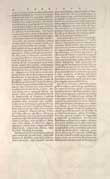Blaeu Atlas of Scotland, 1654
| Field | Content |
|---|---|
| Name: | Blaeu, Joan, 1596-1673 |
| Title: | Twediae. Lavuderdalia |
| Pagination: | 34-33 |
| Zoom view: | Click on the image to view in greater detail |
| 38 / 162 Scroll through pages: 


 | |
Translation of text:
and quiet air. The land often swells into mountains; those which closely overlook the Tweed and the banks of the other rivers on either side are green, lovely and very suited for pasture. Here too there are many valleys and plains lying on either bank of the Tweed and the other rivers; some of them produce grain, some hay, so that this Province is self-sufficient in corn-fields and pastures. Nonetheless the people for the most part live from flocks and herds; for from these they are afforded an abundance of milk, cheese and butter. In the more low-lying places in the Province, where it comes closest to Selkirk, sheep have such healthy and dry pasture that, what scarcely occurs in other regions, they reach their fifteenth year before dying of old age. In this Province there is only one Royal Burgh, or city, called Peebles, from which the whole Province takes its name; it is situated in a very fine location, viz. between the River Tweed and Peebles Water. This town is famous for five threefold ornaments, that is for three churches, three bell-towers, three gates, three squares, and three bridges; one of these, which crosses the Tweed, has five arches (the Tweed has no other bridge until it reaches Berwick), another of two arches rides over Peebles Water. Not far above Peebles is Neidpath Castle, belonging to the Earl of Tweeddale, hereditary Sheriff of the Province, whose ancestors were formerly called Lords Yester, descended from the most noble family of the Hays of Erroll, and in ancient times lived in these two places. Four miles below Peebles is situated Traquair Castle, belonging to the Earl of Traquair; its situation is extremely desirable with the shade of woods and the beauty of the river flowing past. The other castles and principal houses are Pirn, Grieston, Cardrona, Ormiston, Polippo-castle (in the vernacular Horsburgh Castle), Fabricampium (in the vernacular Smithfield), the castle of Manor, Posso, Caverillum[?], Horrea (in the vernacular Barnes), Dawyck, Drumelzier, Stanhope, Polmood, Bostus of the hawk (in the vernacular Hawkshaw), Kingledores, Cuttlehill, Cardrona, Littlehope, Hartree, Skirling, Netherurd, Kirkurd, Quarter, marsh-hall (in the vernacular Halmyre), Romanno, Drochil, Cringletie, hidden hall (in the vernacular Darnick[?]), Winkston and Foulbrig[?].
There are many mountains in this Province, very few if any of which are rocky. In size and height the others are surpassed by the mountain of the deer (in the vernacular Hart Fell) and by Latodunum of deer-stone (in the vernacular Broad Law); the latter is commended among other features by a great supply of animals and birds, especially francolins variegated with white markings, of the most delicate flavour. On the summit of the mountain a broad plain extends, from which one can see all the regions round about, lying between the great Ocean and the Irish Sea. The remaining mountains are Kingledoors, Cardon Hill, Gaddersnalb, Whonifell, Wormell, Wamlalb, Radinshope, Dollar Law, the Linksbeppus and Minchmuir.
A small stream called Pausalia flows past Drumelzier, entering the Tweed at Drumelzier Church. There is a tradition that in its cemetery was formerly buried the seer Merlin, and a prophecy was formerly related in vernacular verse to this effect: Whenever the Tweed and Pausalia run together at Merlin’s grave, then too without doubt the Scots and the English will be subject to the rule of one and the same King. Peebleans assert that this prophecy was fulfilled on the day that James VI was crowned King of England, for on that day they say that the Tweed and Pausalia, rising in a novel and unusual way, overflowing their channels and pouring their waters out on both sides, had the meeting foretold in the prophecy in the aforesaid cemetery at Merlin’s grave; this occurred then for the first time and has never happened again since that time.
Fuel in this Province is partly sods and peats, of which there is a great supply everywhere in the whole Province, partly coal, which in some places is imported from Lothian, while elsewhere it is supplied from a coal-shaft within the bounds of Peebles itself. There is also a great abundance of lime in various places in the province; so that almost nothing is wanting in this Province, which is necessary for man for daily use, whether one considers food, or clothing, or hearth. As for the parishes and presbyteries of this Province, in it there is one whole presbytery, that is Peebles, together with four parishes belonging to the Presbytery of Biggar. The Presbytery of Peebles consists of these parishes and these alone: Peebles, where is the seat of the presbytery, Innerleithen , Traquair, Kailzie, Manor, Dawyck, Drumelzier, Tweedsmuir, Kirkurd, Stobo, West Linton, Lyne, Newlands, Eddleston. In total fourteen parishes. The remaining four parishes are Glenholm, Kilbucho, Broughton and Skirling.
LAUDERDALE (Section Note)
The valley of Lauder or Lauderdale takes its name from the Leader Water.
This river rises in the mountains which separate this region from Lothian, and increased by various streams heads south, and discharges into the Tweed.
The city and castle of Lauder adorn this valley, as does the Lordship of Thirlestane.
On the east it is coterminous with the Merse, on the south with Tweeddale, which also encloses the west side. Lothian is to the north of it.
Of this region, as also of some others, a full description had been promised by the illustrious and noble Lord John, Earl of Lauderdale etc., but as he took the Royal side in the recent British wars and was captured at the battle of Worcester, he is prevented from doing so (1). Enjoy these, Reader, until he has been restored, or some other has provided better.


